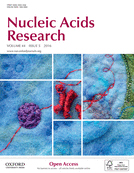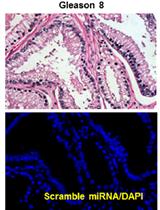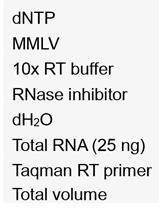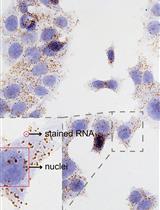- EN - English
- CN - 中文
Affinity Pulldown of Biotinylated RNA for Detection of Protein-RNA Complexes
Pulldown生物素化的RNA以检测蛋白质-RNA复合物
发布: 2016年12月20日第6卷第24期 DOI: 10.21769/BioProtoc.2062 浏览次数: 25938
评审: Antoine de MorreeXiaoyi ZhengEmily Cope
Abstract
RNA-binding proteins (RBPs) have recently emerged as crucial players in the regulation of gene expression. The interactions of RBPs with target mRNAs control the levels of gene products by altering different regulatory steps, including pre-mRNA splicing and maturation, nuclear mRNA export, and mRNA stability and translation (Glisovic et al., 2008). There are several methodologies available today to identify RNAs bound to specific RBPs; some detect only recombinant molecules in vitro, others detect recombinant and endogenous molecules, while others detect only endogenous molecules. Examples include systematic evolution of ligands by exponential enrichment (SELEX), biotinylated RNA pulldown assay, RNA immunoprecipitation (RIP) assay, electrophoretic mobility shift assay (EMSA), RNA footprinting analysis, and various UV crosslinking and immunoprecipitation (CLIP) methods such as CLIP, PAR-CLIP, and iCLIP (Popova et al., 2015). Here, we describe a simple and informative method to study and identify the RNA region of interaction between an RBP and its target transcript (Panda et al., 2014 and 2016). Its reproducibility and ease of use make this protocol a fast and useful method to identify interactions between RBPs and specific RNAs.
Keywords: Tagged RNA (标记的RNA)Background
RNA-protein interactions critically influence gene expression patterns. The identification of these ribonucleoprotein (RNP) complexes is essential for understanding the regulatory mechanisms governed by RNA-binding proteins (RBPs). Recently, extensive efforts have led to the development of methods for systematic analysis of RNA-protein interactions. Highly informative methods to identify RNP complexes include a number of different types of RNP immunoprecipitation (IP) analyses. RIP methods involve RNP IP without crosslinking, while CLIP methods involve crosslinking of the RNP before IP. While RIP is fast, inexpensive, and capable of assessing many endogenous RBPs and RNAs, it does not typically permit the identification of the precise RNA region that interacts with the RBP. CLIP analysis (including its variant forms HITS-CLIP, PAR-CLIP, and iCLIP) does allow the discovery of the precise RNA sequences that interact with an RBP, as it includes an RNase step that digests all unprotected RNA and yields the RNA bound to the RBP. However, CLIP analysis is costly, time-consuming, and technically challenging (Panda et al., 2016). Therefore, alternatives to testing the binding of endogenous proteins to RNAs of interest are needed.
The biotinylated RNA-pulldown method described here theoretically works for all RBPs, as this assay is performed in a cell-free system. The method involves the in vitro synthesis of RNAs of interest in the presence of biotinylated CTP; the RNA tagged in this manner is then incubated with a cell-free system to allow RBPs to recognize RNA regions to which it has affinity, while regions without affinity do not interact with RBPs. After the binding is complete, the biotinylated RNA is pulled down using streptavidin-coated beads and the RBPs are typically detected by Western blot analysis. This method can be used to map the RNA sequence with which the RBP interacts if the user tests progressively smaller RNA fragments in a systematic fashion, as described here. Furthermore, this method allows for the identification of all of the proteins that interact with the RNA of interest if the biotin-RNA pulldown is followed by mass spectroscopy. In summary, this approach can successfully identify the interaction of an endogenous (or recombinant) RBP with in vitro-synthesized RNAs of interest.
Materials and Reagents
- ThermoGridTM rigid strip 0.2-ml PCR tubes (Denville Scientific, catalog number: C18064 [1000859])
- Posi-Click 1.7-ml microcentrifuge tube (Denville Scientific, catalog number: C2171 )
- 1.5-ml tubes
- 10-cm dishes
- NucAway spin columns (Thermo Fisher Scientific, InvitrogenTM, catalog number: AM10070 )
- Disposable cuvettes, 1.5-ml (Stockwell Scientific, catalog number: 2410 )
- Nuclease-free water (Thermo Fisher Scientific, AmbionTM, catalog number: AM9930 )
- cDNA prepared from total RNA
- DreamTaq DNA polymerase (5 U/µl) (Thermo Fisher Scientific, Thermo ScientificTM, catalog number: EP0701 )
- dNTP mix (10 mM each) (Thermo Fisher Scientific, Thermo ScientificTM, catalog number: R0193 )
- Agarose LE (Denville Scientific, catalog number: CA3510-8 )
- QIAquick Gel Extraction Kit (50) (QIAGEN, catalog number: 28704 )
- MEGAshortscriptTM T7 Kit with manual (for RNA shorter than 0.5 Kb) (Thermo Fisher Scientific, InvitrogenTM, catalog number: AM1354 )
- RiboLock RNase inhibitor (40 U/µl) (Thermo Fisher Scientific, Thermo ScientificTM, catalog number: EO0381 )
- Biotin-14-CTP (Thermo Fisher Scientific, InvitrogenTM, catalog number: 19519-016 )
- MEGAscript® T7 Transcription Kit (*for RNA longer than 0.5 Kb) (Thermo Fisher Scientific, InvitrogenTM, catalog number: AM1333 )
- Novex® TBE-urea gels, 6% (Thermo Fisher Scientific, InvitrogenTM, catalog number: EC6865BOX )
- 1x TBE buffer
- Dulbecco’s phosphate-buffered saline (DPBS) (Thermo Fisher Scientific, GibcoTM, catalog number: 14040-133 )
- cOmplete protease inhibitor cocktail (Sigma-Aldrich, catalog number: 11697498001 )
- 2x Laemmli sample buffer (Bio-Rad Laboratories, catalog number: 1610737 )
- Dynabeads® M-280 streptavidin (Thermo Fisher Scientific, InvitrogenTM, catalog number: 11205D )
- 2-mercaptoethanol (β-mercaptoethanol/BME)
- 10x Tris/glycine/SDS running buffer (Bio-Rad Laboratories, catalog number: 1610732 )
- 4-20% Mini-PROTEAN® TGX Stain-FreeTM protein gels (Bio-Rad Laboratories, catalog number: 4568094 )
- Ethidium bromide solution (Sigma-Aldrich, catalog number: E1510 )
- SpectraTM multicolor broad range protein ladder (Thermo Fisher Scientific, Thermo ScientificTM, catalog number: 26634 )
- Bio-Rad protein assay dye reagent concentrate (Bradford reagent) (Bio-Rad Laboratories, catalog number: 500-0006 )
- Tris-HCl (pH 8.0)
- KCl
- MgCl2
- Nonidet P-40
- EDTA
- NaCl
- Triton X-100
- Polysome extraction buffer (PEB) (see Recipes)
- 2x Tris, EDTA, NaCl, Triton (TENT) buffer (see Recipes)
- 1x TENT (see Recipes)
Equipment
- PCR strip tube rotor, mini centrifuge C1201 (Denville Scientific, catalog number: C1201-S [1000806])
- Veriti® 96-Well thermal cycler (Thermo Fisher Scientific, Applied BiosystemsTM, catalog number: 4375786 )
- Ultraviolet transilluminator
- NanoDrop One spectrophotometer (Thermo Fisher Scientific, Thermo Scientific, catalog number: ND-ONE-W )
- Eppendorf Thermomixer® R (Eppendorf, catalog number: 022670581 )
- Incubator
- Vortexer
- Cell scrapers
- Refrigerated centrifuge (Eppendorf, model: 5430R )
- SmartSpec Plus spectrophotometer (Bio-Rad Laboratories, catalog number: 1702525 ) or other spectrophotometer with 595 nm wavelength
- MagneSphere(R) stand (Promega, catalog number: Z5342 )
- Trans-Blot® TurboTM transfer starter system (Bio-Rad Laboratories, catalog number: 1704155 )
- Mini-PROTEAN® Tetra vertical electrophoresis cell (Bio-Rad Laboratories, catalog number: 1658004 )
Procedure
文章信息
版权信息
© 2016 The Authors; exclusive licensee Bio-protocol LLC.
如何引用
Panda, A. C., Martindale, J. L. and Gorospe, M. (2016). Affinity Pulldown of Biotinylated RNA for Detection of Protein-RNA Complexes. Bio-protocol 6(24): e2062. DOI: 10.21769/BioProtoc.2062.
分类
癌症生物学 > 通用技术 > 生物化学试验 > RNA
分子生物学 > RNA > RNA-蛋白质相互作用
分子生物学 > 蛋白质 > 检测
您对这篇实验方法有问题吗?
在此处发布您的问题,我们将邀请本文作者来回答。同时,我们会将您的问题发布到Bio-protocol Exchange,以便寻求社区成员的帮助。
提问指南
+ 问题描述
写下详细的问题描述,包括所有有助于他人回答您问题的信息(例如实验过程、条件和相关图像等)。
Share
Bluesky
X
Copy link













